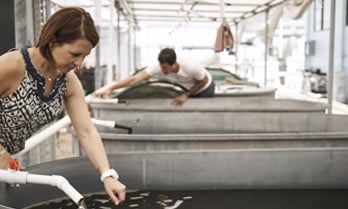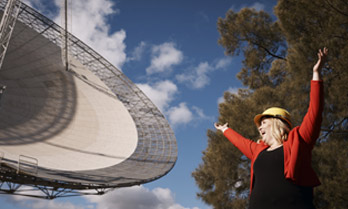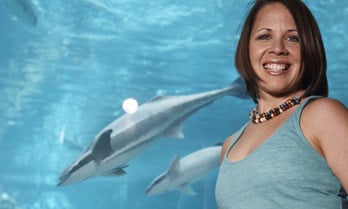Dr Deanna D’Alessandro, University of Sydney
01 September 2011
Mopping up gases
We need better ways of capturing carbon dioxide emissions from power stations and industry. And we won’t be using hydrogen cars until we’ve developed practical ways of carrying enough hydrogen gas in the fuel tank. Deanna D’Alessandro’s understanding of basic chemistry led her to create new, incredibly absorbent chemicals that could do both these jobs and much more.
It’s all to do with surface area. Working in California and in Sydney she has constructed crystals that are full of minute holes. One teaspoon of the most effective of her chemicals has the surface area of a rugby field. What’s more, the size and shape of the pores can be customised using light. So she believes she can create molecular sponges that will mop up carbon dioxide, hydrogen, or in theory almost any gas – and then release it on cue.
She used her L’Oréal For Women in Science Fellowship to provide equipment, travel support and a summer vacation student to assist her research.
Qualifications
2006 – PhD (Chemistry), James Cook University
2001 – Bachelor of Science with Honours (Chemistry), James Cook University
Career highlights, awards, fellowships, grants
2010-present – University of Sydney Postdoctoral Research Fellow, School of Chemistry, University of Sydney
2010 – James Cook University Outstanding Early Career Alumni Award
2008 – Sustainable Products and Solutions Program Grant, “CO2 capture in alkylamine-appended metal-organic frameworks”, awarded to D. M. D’Alessandro and J. R. Long
2007-2009 – Postdoctoral Research Fellow, Department of Chemistry, University of California, Berkeley, USA
2007-2009 – Royal Commission for the Exhibition of 1851 Research Fellowship. One of six awarded across Commonwealth countries
2007-2008 – Dow Chemical Company Foundation Fellowship of the American Australian Association
2007 – International Union of Pure and Applied Chemistry (IUPAC) Prize for Young Chemists for the most outstanding PhD theses in the chemical sciences (one of five awarded worldwide)
2007 – Fresh Science/British Council Australia study tour of the UK
2006-2007 – Postdoctoral Research Fellow, Molecular Electronics Group, University of Sydney
2006 – Royal Australian Chemical Institute (RACI) Cornforth Medal for the most outstanding PhD thesis submitted in a branch of chemistry in Australia
2003 – James Cook University Doctoral Research Scheme Grant to undertake research in the Centre for Nanotechnology, Northwestern University, USA
2001 – Australian Postgraduate Award
2000 – University Medal, James Cook University
Research highlights
- More than 25 presentations at Australian and international conferences and institutions, including eight invited conference and seminar presentations
- Twenty five publications including 16 first-author journal articles and four reviews (all as first author); and a further three articles for mainstream science publication
- Active role in undergraduate teaching at The University of Sydney as well as supervision of Honours students
Top five publications
D.M. D’Alessandro, B. Smit, J.R. Long, “Carbon dioxide capture: prospects for new materials”, Angewandte Chemie Int. Ed. 2010, published on the web 27/07/2010, DOI: 10.1002/anie.201000431. Impact factor: 11.025; Citation score: none available, in press.
B. Bechlars, D.M. D’Alessandro, D.M. Jenkins, A.T. Iavarone, S.D. Glover, C.P. Kubiak and J.R. Long, “High-spin ground states via electron delocalization in mixed-valence imidazolate-bridged divanadium complexes”,Nature Chemistry 2010, 2(5), 362-368.
Demessence, D.M. D’Alessandro, M.L. Foo and J.R. Long, “Strong CO2 binding in a water-stable, triazolate-bridged metal-organic framework functionalised with ethylenediamine”, Journal of the American Chemical Society 2009, 131, 8784-8786. Impact factor: 8.256; Citation score: 9.
D.M. D’Alessandro and F.R. Keene, “Current trends and future challenges in the experimental, theoretical and computational analysis of intervalence charge transfer (IVCT) transitions”, Chemical Society Reviews2006, 35, 424-440. Impact factor: 17.730; Citation score: 43.
D.M. D’Alessandro and F.R. Keene, “Intervalence charge transfer (IVCT) in trinuclear and tetranuclear complexes of iron, ruthenium and osmium”, Chemical Reviews 2006, 106(6), 2270-2298. Impact factor: 28.577; Citation score: 48.




